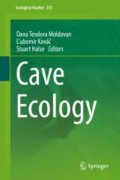Abstract
The different characteristics of three lava tubes in Tenerife, Canary Islands, are analysed. Cueva del Viento-Sobrado, Cueva de Felipe Reventón and Cueva de los Roques were formed by an eruption of Pico Viejo volcano 27,000 years ago. Geological features of this basaltic lava flow and special topographic aspects of its caves are explained. Ecological traits of lava tubes in general are considered, noting the importance for the cave-dwelling animal community of the plant roots that reach them. The present successional state and conservation status of the three lava tubes are also discussed. Two of the caves are among the world’s richest caves in troglobionts and are the most diverse of known volcanic caves. A list of the 50 troglobiont species found in these caves is provided, with information on their taxonomy and trophic roles and the existence of related epigean species. Finally, the possible alternative hypotheses for the origin of the troglobionts of Tenerife are commented.
Access this chapter
Tax calculation will be finalised at checkout
Purchases are for personal use only
References
Arechavaleta M, Oromí P, Sala LL et al (1996) Distribution of carbon dioxide concentration in Cueva del Viento (Tenerife, Canary Islands). In: Oromí P (ed) Proceedings 7th international symposium on Vulcanospeleology, Santa Cruz de La Palma, Canary Islands, Nov. 1994. Los Libros de la Frontera, Sant Cugat del Vallés, pp 11–14
Arechavaleta M, Zurita N, Camacho A et al (1998) La fauna invertebrada de tres cavidades volcánicas del Parque Nacional del Teide (Tenerife): Los Roques, Cuevas Negras y Chavao. Rev Acad Canaria Ciencias 10:65–78
Arechavaleta M, Sala L, Oromí P (1999) La fauna invertebrada de la Cueva de Felipe Reventón (Icod de los Vinos, Tenerife, Islas Canarias). Vieraea 27:229–244
Arnedo MA, Oromí P, Múrria C et al (2007) The dark side of an island radiation: systematics and evolution of troglobitic spiders of the genus Dysdera Latreille (Araneae: Dysderidae) in the Canary Islands. Invertebr Syst 21:623–660
Ashmole NP, Oromí P, Ashmole MJ et al (1992) Primary faunal succession in volcanic terrain: lava and cave studies in the Canary Islands. Biol J Linn Soc 46:207–234
Carracedo JC, Rodríguez-Badiola E, Paris R et al (2008) Erupciones del edificio central. In: Carracedo JC (ed) El volcán Teide, vol 3. Ediciones y Promociones Saquiro, Santa Cruz de Tenerife
Contreras-Díaz HG, Moya O, Oromí P et al (2007) Evolution and timescale diversification of the forest and hypogean ground-beetle radiation of the genus Trechus in the Canary Islands. Mol Phylogenet Evol 42:687–699
Culver DC, Pipan T (2013) Subterranean ecosystems. In: Levin SA (ed) Encyclopedia of biodiversity, 2nd ed, vol 7. Academic, Waltham, pp 49–62
da Gama MM, Ferreira CS (2000) Collembola from two caves of Tenerife, Canary Islands. Mém Biospéol 27:143–145
Enghoff H (2012) Three new species of Dolichoiulus millipedes from the underground of Gran Canaria, with notes on the circumscription of the genus (Diplopoda, Julida, Julidae). Eur J Taxon 15:1–12
Gulden B (2015) World’s longest lava tubes. www.caverbob.com
Hlaváč P, Oromí P, Bordoni A (2006) Catalogue of troglobitic Staphylinidae (Pselaphinae excluded) of the world. Subterr Biol 4:19–28
Hoch H, Asche M (1993) Evolution and speciation of cave-dwelling Fulgoroidea in the Canary Islands (Homoptera: Cixiidae and Meenoplidae). Zool J Linnean Soc 109:53–101
Howarth FG (1973) The cavernicolous fauna of Hawaiian lava tubes, 1. Introduction. Pac Insects 15:139–151
Howarth FG (1996) A comparison of the ecology and evolution of cave-adapted faunas in volcanic and karstic caves. In: Oromí P (ed) Proceedings 7th international symposium on Vulcanospeleology, Santa Cruz de La Palma, Canary Islands, Nov. 1994. Los Libros de la Frontera, Sant Cugat del Vallés, pp 63–68
Martín JL, Oromí P (1986) An ecological study of Cueva de los Roques lava tube (Tenerife, Canary Islands). J Nat Hist 20:375–388
Martínez A, Gonzalez BC, Núñez J et al (2016) Guide to the anchialine ecosystems of Jameos del Agua and Túnel de la Atlántida. Cabildo de Lanzarote
Masson DG, Watts AB, Gee MJR et al (2002) Slope failures on the flanks of the western Canary Islands. Earth Sci Rev 57:1–35
Montoriol J, de Mier J (1974) Estudio vulcanoespeleológico de la Cueva del Viento (Icod de los Vinos, Tenerife, Canarias). Speleon 21:5–24
Oromí P (ed) (1995) La Cueva del Viento. Consejería de Política Territorial, Santa Cruz de Tenerife, 98 pp
Oromí P (2004) Canary Islands: biospeleology. In: Gunn J (ed) Encyclopedia of caves and karst science. Fitzroy Dearborn, New York, pp 179–181
Oromí P, Martín JL (1992) The Canary Islands. Subterranean fauna, characterization and composition. In: Camacho AI (ed) The natural history of biospeleology. C.S.I.C, Madrid, pp 527–567
Rando JC, Sala L, Oromí P (1993) The hypogean community of Cueva del Llano (Fuerteventura, Canary Islands). Mém Biospéol 20:189–193
Wilkens H, Iliffe TM, Oromí P et al (2009) The Corona lava tube, Lanzarote: geology, habitat diversity and biogeography. Mar Biodivers 39:155–167
Wood C, Mills MT (1977) Geology of the lava tube caves around Icod de los Vinos, Tenerife. Trans Br Cave Res Assoc 4:453–469
Acknowledgements
I am indebted to Juan S. Socorro for his pictures of the caves and for comments on geology, to Antonio J. Pérez for his collaboration studying Los Roques cave fauna, to Ángel Vera for an original drawing, to Heriberto López for his arrangements on some figures and to Philip Ashmole for revising the text and the English version. Most of the information included herein is due to the task of all GIET members along many years surveying lava tubes and studying their fauna.
Author information
Authors and Affiliations
Corresponding author
Editor information
Editors and Affiliations
Rights and permissions
Copyright information
© 2018 Springer Nature Switzerland AG
About this chapter
Cite this chapter
Oromí, P. (2018). Researches in Lava Tubes. In: Moldovan, O., Kováč, Ľ., Halse, S. (eds) Cave Ecology. Ecological Studies, vol 235. Springer, Cham. https://doi.org/10.1007/978-3-319-98852-8_17
Download citation
DOI: https://doi.org/10.1007/978-3-319-98852-8_17
Published:
Publisher Name: Springer, Cham
Print ISBN: 978-3-319-98850-4
Online ISBN: 978-3-319-98852-8
eBook Packages: Biomedical and Life SciencesBiomedical and Life Sciences (R0)

